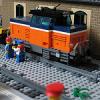
Ball bearing issues? How-to build a "sandwich" structure ball bearing bogie
By
Selander, in LEGO Train Tech
-
Recently Browsing 0 members
No registered users viewing this page.

By
Selander, in LEGO Train Tech
No registered users viewing this page.